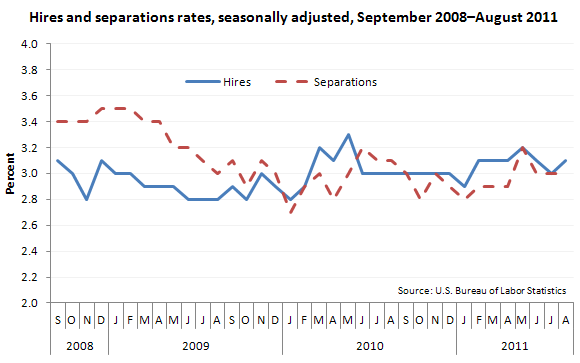Hires vs. Separations: A Recession Retrospective
Although the National Bureau of Economic Research determined conclusively that our most recent recession ended in June 2009, shock-waves from the incident still resonate heavily today. The national unemployment rate still rests at 9.1 percent and the labor market isn’t growing fast enough to outpace population growth and drive down unemployment.
While a rocky road still remains ahead of the U.S. Economy, slight but steady improvements have been made in recent months. According to the Bureau of Labor Statistics, Since April 2011, payroll employment has increased by an average of 72,000 jobs per month (Employment was averaging an increase of 161,000 for the prior 7 months).
The graph below reflects rates of hires and separations from September 2008 through August 2011. Hires represent additions to payroll and separations represent quits, layoffs, discharges and other separations:

Separations were highest Dec. 2008 -Feb. 2009. Over this period the separations rate remained steady at 3.5 percent. The month of May 2010 saw the highest hire rate at 3.3 percent. August 2011 (last month) had a hire rate of about 3.1 percent:
“The number of hires in August was 4.0 million, up from 3.6 million in October 2009 (the most recent trough) but below the 5.0 million hires recorded when the recession began in December 2007,” said the B.L.S.
The B.L.S. also noted: “Large numbers of hires and separations occur every month. Over the 12 months ending in August 2011, hires totaled 47.9 million and separations totaled 46.7 million, yielding a net employment gain of 1.2 million based on not seasonally adjusted data.”

